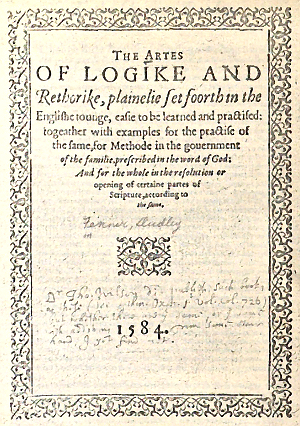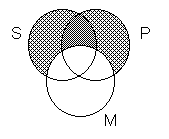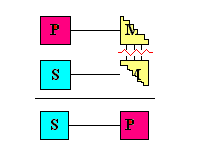|
|
|

The Nature of Logic
Abstract: Logic is defined and described with
examples; deductive arguments are distinguished from inductive
arguments. Logic differs from psychology as it is a prescriptive
science rather than a descriptive science.
- What is logic?
Logic is the study of the methods and principles
used in distinguishing correct from incorrect reasoning.
- As a discipline which evaluates arguments of different kinds, logic is the
study of how a concluding statement logically follows from another statement or
statements (termed premises) either with some probability or with certainty.
- Logic differs from psychology in being a normative or a prescriptive
discipline rather than a descriptive discipline.
- I.e., logic prescribes how we ought to reason; it's not
directly concerned with describing how people actually do reason in their
everyday activities —
although both formal and informal logic are often used to evaluate reasoning
in the public sphere.
- So, logic provides the rules for correct thinking, and identifies fallacies
of incorrect thinking.
- Consequently, logic distinguishes good arguments from poor arguments.
- Important: The logic examples used in the remainder of this page are
for illustration of the types of problems studied in this course. You are not
expected to understand anything in detail — the examples are provided only
to suggest some of the skills which will acquired in this course.
- How logic helps reasoning:
- The practice solving logic examples and constructing good arguments improves
logic skills. Some examples of how this course can help our reasoning skill can be
suggested by looking at a few common arguments.
- Consider the following syllogism
close ×
Syllogism
“A syllogism (properly, a categorical syllogism) is the
inference of one proposition from two premises.”
Simon Blackburn, The Oxford Dictionary of
Philosophy (Oxford: Oxford University Press, 1994), 368. from Thomas Blundeville's 1619 The Art of Logicke:
“Every covetous man doth violate the Lawes of
liberalitie;
but every prodigall man doth violate the Lawes of
liberalitie;
therefore every prodigall man is a covetous man.”
In today's English, Blundeville is arguing here:
Since both greedy people and wasteful people don't freely share,
wasteful people are greedy.
It will become easy for us to recognize the fallacy in this argument as a
fallacy of the undistributed middle term. Or, in plain language,
just because two different things are alike in one characteristic doesn't
mean that one of them is necessarily part of the other.
To glimpse why this is the case, consider that the argument is just like
claiming:
All dogs are animals.
All cats are animals.
∴ All cats are dogs.
The form of the Blundeville's argument and the form of the cat argument
are identical.
- Evaluate the following informal argument stated by Air Chief Hugh
Marshall Lord Dowding, who led the Royal Air Force in World War II:
“More than 10,000 [UFO] sightings have been reported, the majority
of which cannot be accounted for by any ‘scientific’
explanation … I am convinced that these objects do exist and they
are not manufactured by any nation on earth. I can therefore see no
alternative to accepting the theory that they come from an extraterrestrial
source.
While this argument might seem convincing, consider this
counter-example
close ×
Counter-Example
(Or, it is sometimes termed “Counter-Instance.”)
“A particular example that demonstrates that a universal generalization
is false.” [partial definition]
Virginia Klenk,
“Counter-Instance” in The Cambridge Dictionary of
Philosophy, ed. Robert Audi (Cambridge: Cambridge University Press,
1995), 164. about money put under a child's pillow
during the night after the child loses the first primary (baby)
tooth:
In spite of the large number of quarters put under kid's pillows which can
be attributed to sneaky parents, there are hundreds of cases which cannot
account for the source of the money. Therefore, what better evidence could
there be for the existence of the tooth fairy?
The UFO argument is an example of an informal fallacy termed the
argumentum ad ignoratiam; it's a
common fallacy often used by promoters who have flimsy evidence to support
their beliefs.
- As well, this course can help with “the negative approach” in that
we can avoid errors by being aware of common mistakes in logic e.g., being
aware of common formal and informal fallacies.
- For example, how would you evaluate the following argument drawn from
dialogue in a novel:
“Who did he think he was, Napoleon, because he was so
short?”
In this short implicit argument, the fallacy of false cause (or
non causa pro causa) occurs. If this inference
were to be adequate, all, or most, short persons would have to presumed
to become great like Napoleon.
- Here's another example of a common error from a historical study:
“Contrary to the commonly held belief that in
antiquity and as late as 1700 A.D. normal lifespan was about 35 years,
there are indications that the ancient Greeks lived longer. …
A limited number of skeletal findings and demographic data have
encouraged amongst scientists and laymen alike the general opinion
… the average length of life was about 35 years. …
[But]
All men living in Greece in the 5th and 4th century B.C.
whose data of birth and death have been documented with certainty by
grammarians and historians [were found to have a mean length of life of]
71 ± 13.4 years.”
The reasoning here is another kind of fallacy of distribution: there is an
essential difference between an average lifespan estimate with infant
mortality data included and an average lifetime estimate excluding that data.
So the commonly held belief that the normal lifespan in antiquity was about
35 years confuses the “normal” lifespan with the average lifespan.
- Methods, criteria, and techniques, all are given in this course for the
development of procedures to test for argument correctness. Here are some
illustrations of a few approaches we will be learning and using in this course
of study.
- For example, we can test problem I, A stated above by drawing a
Venn Diagram to show the fallacy of the
undistributed middle term. This can be facilitated by first
“translating” the argument into a simplier form as follows:
-
All [covetous men]P are [violators of liberality]M
All [prodigal men]S are [violators of liberality]M
Thus, all [prodigal men]S are [covetous
men]P.

-
Here, the shaded lines are drawn in those sections of the overlapping circles
where the two premises indicate there is an absence of all individuals. Areas
where no shaded lines are drawn are areas in which individuals have not been
be eliminated by the two premises.
So the first statement means that all of the P's (covetous men) are
”pushed into” the area of the M's (violators of liberality)
— the empty lens area between the P and M circles.
We can see there is a small area in the lower part of the S circle
which is not shaded. The unmarked area indicates not all S (prodigal
men) have been definitely excluded from the overlapping P
(covetous men) circle.
So the diagram indicates that the premises do not exclude the possibility
that there could be some S's which are not P's. This means
the premises do not prove with certainty that “All S's ([prodigal
men) are P's (covetous men).
Therefore, the conclusion of this argument has not been proved, and this
argument commits a fallacy (the fallacy of an undistributed middle term).
- We can show the fallacy in this example by appealing to specific
rules known rules of the syllogism by looking at its form:
All P is M U
All S is M U
All S is P
The term M shared by both premises is said to be undistributed because as part of the predicate
of these two statements, M does not refer to each and every person
who is a violator of liberality, but only those M's who are either
covetous or prodigal men. But these are not the only persons who are violators
of liberality. We cannot be sure that either the covetous or the prodigal
men referred to in these statement have any definite relation specifically
to each other.
So the fallacy of the undistributed middle term is based on the
violation of a rule like this:
Rule: In a valid standard form categorical syllogism, the middle
term must be distributed in at least one premise.
Another way to envision this fallacy is to study the following diagram:

For the two terms of the conclusion to be connected through the third, as
in the mechanism shown here, at least one term must be related to the whole
of the class designated by the middle term.
- There are many kinds of logic which exhibit a kind of family relation to each other:
dialectic, classical, symbolic, multivalued, deontic, fuzzy, etc.
- In this course, basically, we will study two general types of logic: classical
deductive and inductive logic.
- Deductive Logic is concerned with
determining when an argument is valid (i.e., deals with conclusive
inferences).
A deductive argument
is one in which it is claimed that the conclusion follows
with necessity.
- If that claim is not met, then the argument is said to be invalid.
- Consider this example from Time magazine's discussion
concerning the assassination of U.S. President John F. Kennedy:
“Since tests proved that it took at least 2.3 seconds to operate
the bolt on Oswald's rifle, Oswald obviously could not have fired three
times — hitting Kennedy twice and Conally once — in 5.6
seconds or less.“
The Time magazine essay assumes it takes 2.3 seconds to load
a round and fire one shot, so it would would require 6.9 seconds to fire
three shots:
2.3 sec. — 1st shot.
2.3 sec. — 2nd. shot.
2.3 sec. — 3rd shot.
6.9 sec. — total time.
So under these assumptions the assassin Lee Harvey Oswald could not have
fired all three shots. In a subsequent issue of Time, Frederick
T. Wehr points out that this apparently indisputable argument was fallacious:
“This argument, which has appeared in many publications since
the assassination, is faulty, and I am surprised that I haven't seen
it refuted before this. Assuming that the bolt of Oswald's rifle can,
in fact, be operated in 2.3 seconds, then Oswald definitely could
fire 3 shots in less than 5.6 seconds, for a stop watch would be
started when the first shot was fired; the second shot would be fired
when the stop watch read 2.3 seconds, and the third shot would be
fired when the stop watch read 4.6 seconds. You have apparently
overlooked the fact that, in the time it takes to fire 3 shots, it is
only necessary to operate the bolt twice.”
The time for the first load need not be counted since Oswald could have
loaded the cartridge well before the first shot was fired.
0.0 sec. — 1st shot.
2.3 sec. — 2nd. shot.
2.3 sec. — 3rd shot.
4.6 sec. — total time.
Consequently, the rifle could have been fired in 5.6 seconds or less.
Inductive Logic is
concerned with the correctness of inferences for which the evidence is not
conclusive — inductive logic involves only probable inferences.
- Hence, an inductive argument is one whose conclusion is claimed to
follow with probability.
- Consider this example from Mark Twain:
“[A]t bottom I did not believe I had touched that man. The law
of probabilities decreed me guiltless of his blood, for in all my
small experience with guns I had never hit anything I had tried to
hit and I knew I had done my best to hit him.”
Within the context of the fictional story, Mark Twain's humorous
retelling is an argument whose reasoning would result in a conclusion
with some probability.
 Or consider the inductive extrapolation techniques used in stock
market prediction by Wall Street traders, e.g., the wedge formation
in a stock chart:
Or consider the inductive extrapolation techniques used in stock
market prediction by Wall Street traders, e.g., the wedge formation
in a stock chart:
Stock market analysts argue that the rising-wedge trend signals a downward
trend in a stock or bond price based on past experience. The inductive claim
is that this trend will probably continue to be mostly reliable for future
stock and bond price wedge-formations.
- What logic is not:
- Logic is not the science of the laws of thought; hence, logic is
distinguished from psychology which is a descriptive science.
- Sometimes people can come to realize future possibilities —
conclusions reliably reached without being able to know or explain how
the conclusion came about. E.g., C.J. Jung suggests that such an
ability is characteristic of the intuitive type of personality.
The unconscious “logic” involved here is part of psychology,
not logic.
- Often people can come to the right conclusion for the wrong reasons;
however, logic is the study of the modes of correct reasoning which
arrive at the right conclusion manifested in an prescriptive, not
descriptive, manner.
- Logic is not really the science of reasoning either because the logician
is not specifically interested, as we have said, in the psychological processes of
reasoning.
- Instead, logicians are interested in the structure of
arguments.
- In sum, people infer
close ×
Inference
“The process of reasoning whereby starting from one or more
propositions accepted as true, the mind passes to another proposition or
propositions whose truth is believed to be involved in the truth of the former.
Inference is a psychological process connecting propositions asserted to be
true and is to be distinguished from implication, the logical relation which
holds between the same propositions when the inference is valid.”
Dagobert Runes, Dictionary of Philosophy, Paterson,
NJ: Littlefield, 1962, 146. statements and statements entail
close ×
Entailment
“The relationship between a set of premises and a conclusion when
the conclusion follows from the premises, or may be validly be inferred from
the premises. Many philosophers identify this with it being logically impossible
that the premises should all be true, yet the conclusion false.”
Simon Blackburn, The Oxford Dictionary of Philosophy
(Oxford: Oxford University Press, 1994, 120. other statements.
- An entailment can hold between statements even though, at the time, it could be
that no one understands the entailment is correct.

Notes: Nature of Logic
Hyperlinks go to page cited.
“Logic is the science of the laws of thought, in relation to the end which
our cognitive faculties propose, — i.e. the true”
Hamilton's definition was cited in William Spalding's entry
“Logic”
in the 1858 Encyclopæia Britannica and subsequently used in many
prominent 19th century logic texts. This definition has occurred as late as 1914 in
George H. McNair's A
Class Room Logic, Deductive and Inductive (Nyacjm NY: Ethlas Press),
4.↩

|
|





 Or consider the inductive extrapolation techniques used in stock
market prediction by Wall Street traders, e.g., the wedge formation
in a stock chart:
Or consider the inductive extrapolation techniques used in stock
market prediction by Wall Street traders, e.g., the wedge formation
in a stock chart: